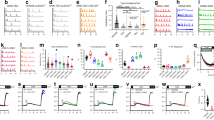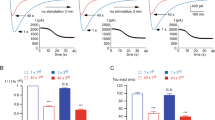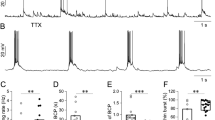Abstract
Acute modulation of P/Q-type (α1A) calcium channels by neuronal activity-dependent changes in intracellular Ca2+ concentration may contribute to short-term synaptic plasticity1,2,3, potentially enriching the neurocomputational capabilities of the brain4,5. An unconventional mechanism for such channel modulation has been proposed6,7 in which calmodulin (CaM) may exert two opposing effects on individual channels, initially promoting (‘facilitation’) and then inhibiting (‘inactivation’) channel opening. Here we report that such dual regulation arises from surprising Ca2+-transduction capabilities of CaM. First, although facilitation and inactivation are two competing processes, both require Ca2+-CaM binding to a single ‘IQ-like’ domain on the carboxy tail of α1A8; a previously identified ‘CBD’ CaM-binding site6,7 has no detectable role. Second, expression of a CaM mutant with impairment of all four of its Ca2+-binding sites (CaM1234) eliminates both forms of modulation. This result confirms that CaM is the Ca2+ sensor for channel regulation, and indicates that CaM may associate with the channel even before local Ca2+ concentration rises. Finally, the bifunctional capability of CaM arises from bifurcation of Ca2+ signalling by the lobes of CaM: Ca2+ binding to the amino-terminal lobe selectively initiates channel inactivation, whereas Ca2+ sensing by the carboxy-terminal lobe induces facilitation. Such lobe-specific detection provides a compact means to decode local Ca2+ signals in two ways, and to separately initiate distinct actions on a single molecular complex.
This is a preview of subscription content, access via your institution
Access options
Subscribe to this journal
Receive 51 print issues and online access
$199.00 per year
only $3.90 per issue
Buy this article
- Purchase on Springer Link
- Instant access to full article PDF
Prices may be subject to local taxes which are calculated during checkout





Similar content being viewed by others
References
Borst, J. G. & Sakmann, B. Facilitation of presynaptic calcium currents in the rat brainstem. J. Physiol. (Lond.) 513, 149–155 (1998).
Cuttle, M. F., Tsujimoto, T., Forsythe, I. D. & Takahashi, T. Facilitation of the presynaptic calcium current at an auditory synapse in rat brainstem. J. Physiol. (Lond.) 512, 723–729 (1998).
Forsythe, I. D., Tsujimoto, T., Barnes-Davies, M., Cuttle, M. & Takahashi, T. Inactivation of presynaptic calcium current contributes to synaptic depression at a fast central synapse. Neuron 20, 797–807 (1998).
Abbott, L. F., Varela, J. A., Sen, K. & Nelson, S. B. Synaptic depression and cortical gain control. Science 175, 220–224 (1997).
Tsodyks, M. V. & Markram, H. The neural code between neocortical pyramidal neurons depends on neurotransmitter release probability. Proc. Natl Acad. Sci. USA 94, 719–723 (1997).
Lee, A. et al. Ca2+/calmodulin binds to and modulates P/Q-type calcium channels. Nature 399, 155–159 (1999).
Lee, A., Scheuer, T. & Catterall, W. A. Ca2+/calmodulin-dependent facilitation and inactivation of P/Q-type Ca2+ channels. J. Neurosci. 20, 6830–6838 (2000).
Peterson, B. Z., DeMaria, C. D., Adelman, J. P. & Yue, D. T. Calmodulin is the Ca2+ sensor for Ca2+-dependent inactivation of L-type calcium channels. Neuron 22, 549–558 (1999).
Chao, S. H., Suzuki, Y., Zysk, J. R. & Cheung, W. Y. Activation of calmodulin by various metal cations as a function of ionic radius. Mol. Pharmacol. 26, 75–82 (1984).
Colecraft, H. M., Patil, P. G. & Yue, D. T. Differential occurrence of reluctant openings in G-protein-inhibited N- and P/Q-type calcium channels. J. Gen. Physiol. 115, 175–192 (2000).
Zuhlke, R. D., Pitt, G. S., Deisseroth, K., Tsien, R. W. & Reuter, H. Calmodulin supports both inactivation and facilitation of L-type calcium channels. Nature 399, 159–162 (1999).
Zuhlke, R. D., Pitt, G. S., Tsien, R. W. & Reuter, H. Ca2+-sensitive inactivation and facilitation of L-type Ca2+ channels both depend on specific amino acid residues in a consensus calmodulin-binding motif in the α1C subunit. J. Biol. Chem. 275, 21121–21129 (2000).
Qin, N., Olcese, R., Bransby, M., Lin, T. & Birnbaumer, L. Ca2+-induced inhibition of the cardiac Ca2+ channel depends on calmodulin. Proc. Natl Acad. Sci. USA 96, 2435–2438 (1999).
Peterson, B. Z. et al. Critical determinants of Ca2+-dependent inactivation within an EF-hand motif of L-type Ca2+ channels. Biophys. J. 78, 1906–1920 (2000).
Houdusse, A. & Cohen, C. Target sequence recognition by the calmodulin superfamily: implications from light chain binding to the regulatory domain of scallop myosin. Proc. Natl Acad. Sci. USA 92, 10644–10647 (1995).
Elshorst, B. et al. NMR solution structure of a complex of calmodulin with a binding peptide of the Ca2+ pump. Biochemistry 38, 12320–12332 (1999).
Ehlers, M. D., Zhang, S., Bernhardt, J. P. & Huganir, R. L. Inactivation of NMDA receptors by direct interaction of calmodulin with the NR1 subunit. Cell 84, 745–755 (1996).
Putkey, J. A., Sweeney, H. L. & Campbell, S. T. Site-directed mutation of the trigger calcium-binding sites in cardiac troponin C. J. Biol. Chem. 264, 12370–12378 (1989).
Mori, M. et al. Novel interaction of the voltage-dependent sodium channel (VDSC) with calmodulin: does VDSC acquire calmodulin-mediated Ca2+-sensitivity? Biochemistry 39, 1316–1323 (2000).
Keen, J. E. et al. Domains responsible for constitutive and Ca2+-dependent interactions between calmodulin and small conductance Ca2+-activated potassium channels. J. Neurosci. 19, 8830–8838 (1999).
Fanger, C. M. et al. Calmodulin mediates calcium-dependent activation of the intermediate conductance KCa channel, IKCal. J. Biol. Chem. 274, 5746–5754 (1999).
Erickson, M. G. & Yue, D. T. FRET reveals tethering of calmodulin to calcium channel complex in single living cells. Biophys. J. 80, 196a (2001).
Rodney, G. G. et al. Calcium binding to calmodulin leads to an N-terminal shift in its binding site on the ryanodine receptor. J. Biol. Chem. 276, 2069–2074 (2001).
Barth, A., Martin, S. R. & Bayley, P. M. Specificity and symmetry in the interaction of calmodulin domains with the skeletal muscle myosin light chain kinase target sequence. J. Biol. Chem. 273, 2174–2183 (1998).
Kink, J. A. et al. Mutations in paramecium calmodulin indicate functional differences between the C-terminal and N-terminal lobes in vivo. Cell 62, 165–174 (1990).
Ohya, Y. & Botstein, D. Diverse essential functions revealed by complementing yeast calmodulin mutants. Science 263, 963–966 (1994).
Sutton, K. G., McRory, J. E., Guthrie, H., Murphy, T. H. & Snutch, T. P. P/Q-type calcium channels mediate the activity dependent feedback of syntaxin-1A. Nature 401, 800–804 (1999).
Kincaid, R. L., Billingsley, M. L. & Vaughan, M. Preparation of fluorescent, cross-linking, and biotinylated calmodulin derivatives and their use in studies of calmodulin-activated phosphodiesterase and protein phosphatase. Methods Enzymol. 159, 605–626 (1988).
Patil, P. G., Brody, D. L. & Yue, D. T. Preferential closed-state inactivation of neuronal calcium channels. Neuron 20, 1027–1038 (1998).
Song, L. S., Sham, J. S., Stern, M. D., Lakatta, E. G. & Chang, H. Direct measurement of SR release flux by tracking ‘Ca2+ spikes’ in rat cardiac myocytes. J. Physiol. (Lond.) 512, 677–691 (1998).
Acknowledgements
We thank W. Agnew, C. Chen, H. Colecraft, M. Erickson, S. Takahashi, H. Agler and E. Sobie for discussion; B. Peterson for initial attempts to detect P/Q-type channel facilitation; and T. Snutch for the gift of human α1A clone. This work was supported by an NIH NRSA fellowship (C.D.D.) and grants from the NIH (D.T.Y.) and NNI (T.W.S.).
Author information
Authors and Affiliations
Corresponding author
Supplementary information
Rights and permissions
About this article
Cite this article
DeMaria, C., Soong, T., Alseikhan, B. et al. Calmodulin bifurcates the local Ca2+ signal that modulates P/Q-type Ca2+ channels. Nature 411, 484–489 (2001). https://doi.org/10.1038/35078091
Received:
Accepted:
Issue Date:
DOI: https://doi.org/10.1038/35078091
This article is cited by
-
Presynaptic calcium channels: specialized control of synaptic neurotransmitter release
Nature Reviews Neuroscience (2020)
-
A calcium-influx-dependent plasticity model exhibiting multiple STDP curves
Journal of Computational Neuroscience (2020)
-
Calmodulin is responsible for Ca2+-dependent regulation of TRPA1 Channels
Scientific Reports (2017)
-
Conformational heterogeneity of the calmodulin binding interface
Nature Communications (2016)
Comments
By submitting a comment you agree to abide by our Terms and Community Guidelines. If you find something abusive or that does not comply with our terms or guidelines please flag it as inappropriate.



